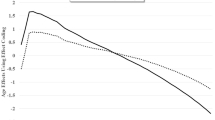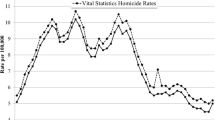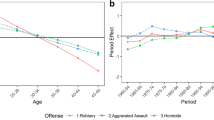Abstract
Even if a researcher found a constraint that correctly identified an age-period-cohort multiple classification (APCMC) model, the results would not address the issue of how stable these effects are within ages, periods, or cohorts. This occurs because APCMC models are based on the main effects for each age group, each period, and each cohort, and these main effects only assess the additive effects of ages, periods, and cohorts. The main effects of ages are constant across periods and cohorts, the main effects of periods are constant across ages and cohorts, and the main effects of cohorts are constant across ages and periods. I present a method for assessing the stability of age effects within ages, period effects within periods, and cohort effects within cohorts. For example, does the cohort effect for a specific cohort diminish as the cohort ages or is it enhanced; is the period effect for a particular period stronger for younger aged people than for older aged people or does only a single age-group in a particular period deviate from the trend within that period. The proposed measures of the stability of these effects are based on estimable functions from the full APCMC model. Such functions are the same no matter which just identifying constraint is applied to the APCMC model. I illustrate the use of this approach using homicide arrest data for the United States from 1965 to 2015.




Similar content being viewed by others
Notes
I will often refer to the age categorical variables as a factor, and I do the same for the period categorical variables and the cohort categorical variables.
I assume that the age-groups correspond to the interval between periods and the cohorts correspond to the birth years of those in a particular age-group in a particular period.
If we labelled the cells of Table 1 as i for the ith age group (from youngest to oldest) and j of the jth period (from the earliest to the most recent period, then we would write the residuals as \(\left( {y_{ij} - \hat{y}_{ij} } \right)\).
These trends change depending on the just identifying constraint that is placed on the model, but the deviations of the age, period, and cohort effects from the linear trends of their effects are the same using different just identifying constraints on the APCMC model.
Correct specification in this context means that the model contains all of the variables that should be in the model. This is a criterion for all regression models in terms of providing unbiased estimates of the data generating parameters. If the model is correctly specified, then the “true-model” should have a solution that is one of the best fitting solutions.
Depending on the circumstances a researcher might want to calculate the interaction for an observation rather than treat it as a residual.
“To provide a correct identification, simple constraints such as \(\sum \nolimits_{a} \alpha_{a} = \sum \nolimits_{p} \pi_{p} = \sum \nolimits_{c} \gamma_{c} = 0\) imply centered coefficients. We add three constraints, \({\text{slope}}_{a} \left( {\alpha_{a} } \right) = {\text{slope}}_{p} \left( {\pi_{p} } \right) = {\text{slope}}_{c} \left( {\gamma_{c} } \right) = 0\), where slope is the linear function that gives the linear slope of the coefficients, so that \(\alpha_{a}\), \(\pi_{p}\) and \(\gamma_{c}\) are detrended” (Chauvel et al. 2016: 5). Only one of the slope constraints is necessary to identify the model, the other two slope constraints degrade the fit of the fixed effect APCMC model.
This is similar to the situation in mixed models where a researcher treats one of the three factors (ages, periods, or cohorts) as a random variable and the other two factors as fixed. This forces the random factor to have a zero linear trend and identifies the model. Unfortunately, using each of the factors one at a time as the random variable in three different mixed models provides different, often quite different, results (O’Brien 2017).
Informally, the general rationale is that if the APCMC model is correctly specified (an assumption needed for unbiasedness in the typical regression situation), then the set of the best fitting solutions contains the solution based on the data generating parameters. Estimable functions are the same for all of these best fitting solutions, and therefore are the same as those based on the data generating parameters, if the APCMC model is correctly specified.
I am imagining the data arrayed in an age by period table with age on the rows, period on the columns, and therefore cohorts on the diagonals: a table such as Table 1, but with residuals in the cells rather than rates.
I use effect coding (sum to zero coding) throughout this paper, so that the intercepts for the ages, period, and cohorts are absorbed by the a single intercept term: \(\mu\). This representation of the APCMC model is based on Holford (2006: 980), though it differs slightly.
I use the jackknife studentized residual from Stata (Statacorp 2013), which is the observed residual divided by the standard deviation for the residuals computed with the observation of interest left out of the calculation of the standard deviation. Note that these residuals are from the trend of observations within an age-group or a period or a cohort.
One reviewer of this paper suggested the possibility of a cross-cohort effects in which a younger cohort influences an older cohort. The reviewer notes that increases in Facebook subscription in a younger cohort may precede increases in an older cohort. This might be detected using structured residuals by examining the residuals for young age groups in a later cohort and seeing those residuals preceded increase in the residuals for older age groups in an earlier cohort. This represents another possible use of patterns in structured residuals.
The studentized residual for age group 55–59 in 1995 is 2.0425. Note that this group’s residual (in Table 2) is 0.097 in 1995, which is unusual given the downward trend for that period.
Eliminating these outliers reduces the standard errors for the trends of those age-groups.
I do not pursue this example further in this paper, since further analysis suggests other outlying studentized residuals that make the analysis untenable given the small number of observations.
For the data on homicide offending in this paper there does not seem to be a strong pattern to support any of these hypotheses.
References
Chauvel, L., Schröder, M.: Generational inequalities and welfare regimes. Soc. Forces 92, 1259–1283 (2014)
Chauvel, L., Schröder, M.: The impact of cohort membership on disposable incomes in West Germany, France, and the United States. Eur. Sociol. Rev. 31, 298–311 (2015)
Chauvel, L., Anja, K.L., Ponomarenko, V.: Testing persistence of cohort effects in the epidemiology of suicide: an age-period-cohort hysteresis model. PLoS ONE (2016). https://doi.org/10.1371/journal.pone.0158538
Clayton, D., Schifflers, E.: Models for temporal variation in cancer rates II: age-period-cohort models. Stat. Med. 6, 468–481 (1987)
FBI (1966, 1971, …, 2016) Various years: crime in the United States. U.S. Government Printing Office, Washington D.C
Hirschi, T., Gottfredson, M.: Age and the explanation of crime. Am. J. Sociol. 89, 552–584 (1983)
Hobcraft, J., Menken, J., Preston, S.: Age, period, and cohort effects in demography: a review. Population Index 1, 4–43 (1982)
Holford, T.R.: The estimation of age, period, and cohort effects for vital rates. Biometrics 39, 311–324 (1983)
Holford, T.R.: Understanding the effects of age, period, and cohort on incidene and mortality rates. Ann. Rev. Public Health 12, 425–457 (1991)
Holford, T.R.: Approaches to fitting age-period-cohort models with unequal intervals. Stat. Med. 25, 977–993 (2006)
Kupper, L.L., Janis, J.M., Salama, I.A., Yoshizawa, C.N., Greenberg, B.G.: Age-period-cohort analysis: an illustration of the problems in assessing interactions in one observation per cell data. Commun Stat Theory Methods 12, 2779–2807 (1983)
Luo, L.: Age-period-cohort analysis: critiques and innovations (dissertation). Retrieved from the University of Minnesota Digital Conservancy (2015). http://hdl.handle.net/11299/182321
Luo, L., Hodges, J.S.: The age-period-cohort-interaction model for describing and investigating inter- and intra-cohort effects (2019). https://arxiv.org/ftp/arxiv/papers/1906/1906.08357.pdf
Merton, R.K.: The Matthew effect in science. Science 159, 56–63 (1968)
Mason, K.O., Mason, W.M., Winsborough, H.H., Poole, W.K.: Some methodological issues in cohort analysis of archival data. Am. Sociol. Rev. 38, 242–258 (1973)
O’Brien, R.M.: Estimable functions of age-period-cohort models: a unified approach. Qual. Quant. 45, 1429–1444 (2014)
O’Brien, R.M.: Mixed models, linear dependency, and identification in age-period-cohort models. Stat. Med. 36, 2590–2600 (2017)
O’Brien, R.M.: Homicide arrest rate trends in the United States: the contribution of periods, and cohorts (1965–2015). J. Quant. Criminol. 35, 211–236 (2019)
O’Brien, R.M., Stockard, J.: Can cohort replacement explain changes in the relationship between age and homicide offending? J. Quant. Criminol. 25, 79–101 (2009)
Searle, S.R.: Linear models. Wiley, New York (1971)
StataCorp: Stata statistical software: release 13. StataCorp LP, College Station, TX (2013)
Author information
Authors and Affiliations
Corresponding author
Additional information
Publisher's Note
Springer Nature remains neutral with regard to jurisdictional claims in published maps and institutional affiliations.
Rights and permissions
About this article
Cite this article
O’Brien, R.M. Estimable intra-age, intra-period, and intra-cohort effects in age-period-cohort multiple classification models. Qual Quant 54, 1109–1127 (2020). https://doi.org/10.1007/s11135-020-00977-9
Published:
Issue Date:
DOI: https://doi.org/10.1007/s11135-020-00977-9




